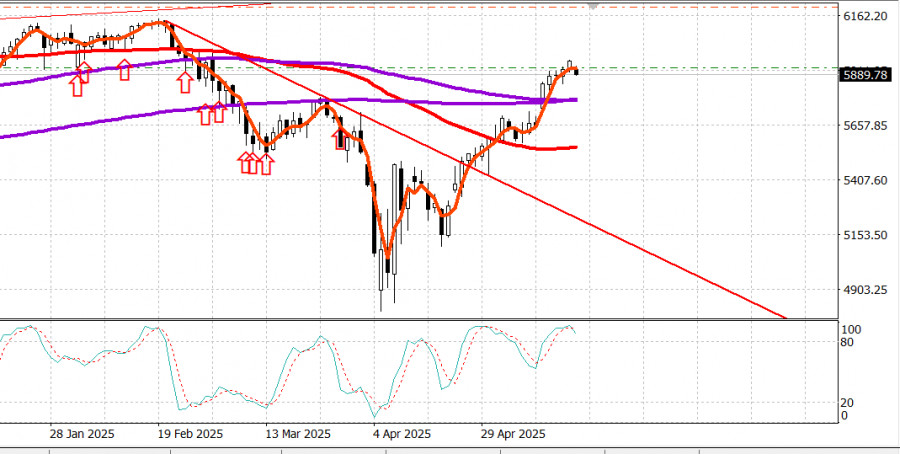S&P 500
Overview for May 19
US credit rating downgrade raises odds of market correction
Major US indices on Friday: Dow +0.8%, NASDAQ +0.5%, S&P 500 +0.7%
S&P 500: 5,958, trading range: 5,400–6,200
The stock market ended the week on a high note. The Dow Jones Industrial Average (+0.8%) closed more than 300 points above its previous finish, turning positive for the year (+0.3%).
The S&P 500 (+0.7%) and Nasdaq Composite (+0.5%) also closed at session highs. Still, the session began on a weaker footing, with major indices trading near or below their previous closing levels.
Subdued early moves were partly driven by the May consumer sentiment report, which showed low confidence and rising inflation expectations.
One-year inflation expectations jumped from 6.5% to 7.3%, while sentiment slipped from 52.2 to 50.8. The preliminary May report was prepared from April 22 to May 13, just two days after the de-escalation of the U.S.-China trade conflict. Therefore, it may not reflect more recent shifts in sentiment prompted by notable tariff developments.
Buying picked up as Friday's session progressed, driven by continued upward momentum and fear of missing further gains.
The market's positive tone was also supported by early signs of resilience, as stocks resisted initial selling pressure.
Many stocks participated in the rally, pushing 10 of the 11 S&P 500 sectors to close higher. Five sectors ended more than 1.0% above their prior closing levels, including healthcare (+2.0%) and utilities (+1.4%). Notably, the gains were led by defensive sectors.
Treasury yields rose after a morning survey showed higher inflation expectations. The yield on the 2-year note, which stood at 3.93% before the 10:00 a.m. ET release, climbed one basis point from yesterday's close to 3.98%. The 10-year yield, which was at 4.40% pre-release, also moved up one basis point to 4.44%.
Year-to-date performance:
S&P 500: +1.3%Dow Jones Industrial Average: +0.3%Nasdaq Composite: -0.5%S&P Midcap 400: -1.1%Russell 2000: -5.2%
Economic data overview:
April housing starts: 1.361 million (consensus: 1.383 million); previous revised from 1.324 million to 1.339 millionApril building permits: 1.412 million (consensus: 1.450 million); previous revised from 1.467 million to 1.481 million
The key takeaway from the housing report is the broad-based weakness in single-family permits across all regions, signaling caution among consumers and developers facing higher home prices, elevated mortgage rates, and increased construction costs.
April import prices: +0.1%; previous revised from -0.1% to -0.4%April import prices ex-petroleum: +0.4%; previous revised from +0.1% to -0.1%April export prices: +0.1%; previous revised from 0.0% to +0.1%April export prices ex-agriculture: +0.1%; previous revised from -0.1% to +0.1%
University of Michigan Preliminary May Consumer Sentiment Index: 50.8 (consensus: 55.0); previous: 52.2
The key takeaway from the report is that it continues to reflect a deterioration in consumer views on personal finances and rising concern about inflation expectations. Notably, this survey was conducted from April 22 to May 13, ending just two days after news broke of tariff reductions between the US and China, meaning it may not fully capture the impact of that development.
Looking ahead to the new week, markets will get fresh data on the labor and housing sectors. Weekly jobless claims are due Thursday morning, while April existing home sales and new home sales are scheduled for release Friday morning.
Late in the week, Moody's downgraded the US credit rating by one notch from its top-tier AAA, leaving the country without the highest rating from any of the three major agencies. The move was a response to the Trump administration's plans to cut taxes and increase spending, despite high levels of national debt, an already sizable budget deficit, and a wide trade gap.
Energy: Brent crude is currently trading at $65.10. Oil halted its decline after Iran's leader responded harshly to Trump's proposal for a deal, issuing insults directed at both the US and Trump himself. The likelihood of a US-Iran agreement has sharply decreased, while the risk of a strike on Iran, possibly by Israel, has increased.
A key event on Monday: Trump is expected to call Putin at 5 p.m. Moscow time, followed by conversations with European leaders regarding a possible peace agreement in Europe.
Conclusion: The US market remains resilient, but the blow from weakening consumer sentiment is significant, and a correction is increasingly likely. Optimism around progress in US-China tariffs persists, but many overlook the fact that even after a reduction from 145% to 30%, a 30% tariff is still steep. It will almost certainly drive a notable rise in US inflation, with all the negative consequences that entails.












